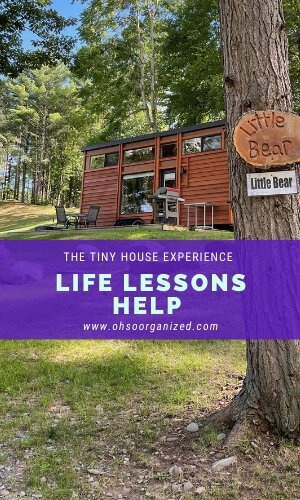One of my obsessions, which you might not know about, is “tiny houses” and the tiny house movement. I am in awe of living with less (less space, less stuff) and how small spaces are designed. I love watching the Netflix show, Tiny House Nation, adding images to my Oh, So Tiny Houses! Pinterest board, and reading about people living the tiny house lifestyle. My fantasy is to sell our home (and most of our stuff) and move into a tiny house.
My husband, Steve, doesn’t share my enthusiasm for this idea. He has expressed many times, “I don’t want to live in a tiny house and get rid of all of my stuff. I like my stuff. Where would I put all of my signs?” Steve is a collector of many things, including large porcelain advertising signs. Then he clarified that if we did move into a tiny house, we’d need two of them to “keep the peace.”
In the early summer, with tiny house fantasies and vacation planning on my mind, I discovered a unique place in the Catskills. A Tiny House Resort, where we could experience firsthand what tiny home living was like. Steve was game and knew this would be fun, but also help me experience viscerally what tiny living was all about. I booked us an adorable 350 square foot little house complete with a full kitchen, bathroom with five-foot tub, space to sleep four people, fire pit, pergola, and outdoor gas grill. What fun! This family-run resort is situated along the Catskill Creek, has beautiful walking trails, a waterfall, and an outdoor heated swimming pool. There are farm animals, including goats (available for Goat Yoga,) sheep, free-range chickens laying fresh eggs that guests can have, vegetable and herb garden to pick from, giant-sized (not tiny) outdoor chess, and checkers, and so much more.
Four Tiny House Life Lessons
Life Lesson One: Defining Too Cozy
My ah-ha moment came when I approached our tiny house, opened the door, and walked in. I knew in an instant that I could never live full-time in one. Why? It was too small. I told Steve, and he smiled- well, maybe he belly laughed. While it was fantastic spending a long weekend there with him in this cozy and unique space, it is not how I want to live all the time. Although we both agreed that we could if we had to.
Life Lesson Two: Not So Small Afterall
The second ah-ha came when we returned back to our own home, which we’ve always called “small.” Our home felt spacious after four days of living in the tiny house. This realization reinforced that my tiny house fantasy is just that- a fantasy. I am happy and deeply grateful to live in our rightly sized home. I felt very much like Goldilocks when she sat in the “just right” chair. I discovered that our house is “just right” for us.
“I want to prioritize being and doing over acquiring and managing. ”
Life Lesson Three: Live With Less
I also recognized that even though I no longer aspire to live in a tiny home, which is defined as between 100 to 400 square feet, I am interested in living with less. It was so apparent how little we needed when we stayed at the tiny house resort. Instead of 30 drinking glasses, there were four. Instead of silverware for 40, there were 4 spoons, forks, and knives. We had just enough, but not more than enough. It felt liberating.
So when I returned home, I started to not just think about editing my stuff. I actually began letting go. A bag of books was filled and donated to the library. I went through my files and filled up three large bags of paper to recycle and shred. That’s just the beginning. My plan is to go through each room and find things that no longer have value, are taking up space, or have overstayed their welcome.
I don’t feel pressure or have a specific timeframe for doing this. It will be a relaxed and ongoing process.
Life Lesson Four: Clarifying My Why
Our tiny house experience inspired me not to move but to discover what living with just enough feels like. I’m hyperaware of the 80/20 rule and frequently share this with clients. We only refer to 20% of the papers we file, wear 20% of the clothes we own, read or refer to 20% of the books on our shelves, use 20% of the kitchen gadgets, and so on. I want to review and potentially let go of close to 80% of the things I never use, access, or need. I recognize this is ambitious, but I am open to the process. Why should the stuff I collected and don’t use take up valuable physical real estate and emotional energy? Why should I leave the things I no longer want for our kids to have to sort through when I’m gone? I acquired these things. It’s my responsibility to decide their future.
Lastly, and perhaps most importantly, our tiny living weekend allowed us the freedom to live and not spend much time caring for the physical stuff of life. Less time cleaning and decision-making meant more time for kayaking, walking in the Catskill Creek, hanging out by the waterfall, swimming, picking peppers and basil from the garden, preparing and eating meals together, and enjoying our time together. Yes. I get that we were on vacation. But even so, going forward, I want to prioritize being and doing over acquiring and managing. We only go around once.
Have you considered tiny house living? If so, do you need help editing? Do you feel overwhelmed by your things, or do you have just enough? I’d love to hear your thoughts. I invite you to join the conversation.














